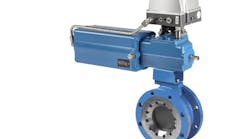Solenoid valves have been used for more than 100 years in many diverse flow control applications across many industries. But their underlying technology has not changed a great deal until recently. Even so, the physics of their operation is not always well understood, leading to misapplications or suboptimal performance. For example, not all users realize that simple solenoid coil excitation with AC rather than DC power usually allows for higher forces, watt-for-watt, in opening a poppet valve. So AC may be helpful against higher differential pressures of the fluid, for instance. However, using DC power often provides other advantages, such as ease of wiring.
Solenoids 101
First, let’s examine the operation of a simplified normally closed poppet valve (Figure 1). When the coil is not energized, no electromagnetic forces are generated; the conical spring (f) presses the disk (a) with its attached core (c) against the orifice (b), stopping flow. The disk is typically made from an elastomeric material to ensure a tight closure. When electrical current is passed through the coil (d), a magnetic field (h) is induced in the magnetically permeable circuit, comprised of the stationary plugnut (e), movable core (c), and yoke (j). The resulting electromagnetic force attempts to close the air gap (g) by moving the core towards the plugnut. When the core lifts, compressing the spring, the disk moves away from the orifice and flow commences. A larger orifice selection allows a greater flow coefficient (or Cv) — the amount of flow for a given pressure drop.
The simplified explanation above works equally well for AC or DC excitation (ignoring a few subtleties of internal construction). But let’s take a closer look at what happens when the valve has just started to open. Force from the spring helps keep the valve closed, but so does hydraulic force caused by the pressure drop from the inlet to the outlet of the valve. This hydraulic force is proportional to the square of orifice size, since the area of pressure imbalance is equal to pi times the orifice radius squared (remember that class in geometry?). This is why such direct-acting valves with greater flow often take a disproportionately larger coil and lifting force to open.
However, once the valve is open and flow commences, this hydraulic force decreases dramatically. So an ideal solenoid valve should have just enough initial magnetic lifting force (from electrical power to the coil) to overcome both spring and hydraulic forces. But once flow starts, the valve should decrease its magnetic
lifting force (and lower its electrical power consumption), only compressing the spring. Asking anything more of the coil simply creates waste heat.
The AC Advantage
Here’s where AC excitation is usually more efficient for solenoid valves, from a power consumption standpoint. Typically, an end-user will apply a voltage to the coil, for example, via a mechanical or solid-state switch. But it’s the current passing through the coil (multiplied by the number of coil turns) that actually creates the magnetic field. This current is equal to the voltage divided by the coil impedance. For an AC sine wave (remember Circuits 101?), this impedance is calculated as R + j*2*pi*f*L, where R is the coil resistance, L is its inductance, f is the AC frequency, and j is a mathematical operator that results in a 90-degree phase shift. As the solenoid valve opens, the air gap quickly narrows (the core accelerates as the magnetic circuit becomes more efficient). That makes the coil’s inductance, L, (and thus the impedance) increase dramatically. As a result, the current decreases after an initial inrush or spike. So using AC excitation achieves the desired result — to open the valve against pressure, then cut down on power (Figure 2).
With DC excitation, the case is reversed. When a DC voltage is applied to a solenoid coil, the current will increase to eventually (asymptotically) equal that voltage divided by the coil resistance. The time it takes to get to that steady-state level is determined by the time constant of L divided by R (coil inductance divided by resistance). Thus DC excitation, with its relatively slow buildup of current, creates exactly the opposite of what is wanted in a solenoid (Figure 3).
Considering the Tradeoffs
Although AC excitation is typically more efficient, it usually comes in the form of high voltages (120/240 V AC) and can bring accompanying user issues, such as wire segregation, shock hazards, infringement of electrical safety codes, and so on. (Low-voltage AC is of course available, but this necessitates a transformer with its own power/heat issues.) Nor is AC excitation without intrinsic losses. Since the voltage/current is cycling in an AC solenoid, substantial "iron losses" (hysteresis and eddy currents) can account for half of its power dissipation.
Also, modern industrial applications using PLCs, DCSs, and so on to automate fluid control systems often provide easier connectivity to DC loads. They may offer more outputs per plug-in module, or the user may want to share one output module between different load types. And DC power busses are often more readily available (e.g., 24 V DC with auctioneered backups in many process plants).
Ideally we want the current waveform "shape" of AC solenoid excitation, without all its problems. Of course, using additional electronic components, we can change the shape of the DC coil current waveform to be closer to the mark. These additional circuits — sometimes called spike and hold — are included within some solenoid valve packages. The simplest example is shown in Figure 4.
When the coil is first energized, current will spike through the capacitor C until that becomes charged, after which resistor R limits current flow through the coil. Problem: With current flowing through an additional resistor or similar heat-
generating component, these approaches are typically confined to smaller-sized solenoid valves. Yet larger solenoids are where we need power conservation most. We want a means of generating a high-current pulse from a DC voltage rail, then reducing that current to conserve power, while maintaining the solenoid valve open — without dropping the steady-state current through a resistor (or linear-mode transistor, etc.) and consuming more power.
New technology currently on the market uses an integral switching system to accept a wide range of input voltages (either AC or DC). The system is programmed to supply increased current to the coil during initial excitation and then drop back to maintenance current. Such valves can deliver much-improved fluid performance, with higher flowrates and pressures, at a fraction of the steady-state electrical power consumption of conventional designs.
Can’t Take the Heat
Conventional solenoid valve solutions can generate considerable energy costs and require large, expensive, separate power supplies. But power delivered to the solenoid is not the only application consideration. That power of course turns into substantial, and troublesome, heat. For example, a bank of 10 conventional 11-watt solenoids in a sealed cabinet can quickly raise internal temperatures beyond the specifications of other electronics in the cabinet. Removing heat from instrumentation systems can require fans, air-conditioning, and so on.
Solenoid coil heat also reduces a valve’s life expectancy. Differing grades of magnet-wire/insulation allow for larger or smaller tolerances for ambient system temperatures, as well as for the increased temperature caused by a valve’s own heat of operation. But the 10 C rule of thumb (based on Arrhenius’s theory and a typical activation energy) suggests that a coil’s thermal life approximately doubles for every 10 C reduction in operating temperature, all other things being equal. For example, if a conventional 11-watt solenoid coil can be reduced to two watts by the current switching system mentioned above, the coil temperature will typically decrease by 40 C, with a lifetime increase of 2^(40/10) = 16.
Assuming such results, it is possible to extend the service life of a solenoid coil from five years to 80 years. Users should take care to optimize performance of a simple solenoid valve to the fluid flowrates and pressures being controlled. Advanced designs now available can significantly reduce power consumption via switched current management, allowing either DC or AC applications to run even more efficiently than previous AC-only coils. These new solenoid valve designs also allow for more widely ranging voltage supplies. In addition, they significantly reduce heat generation and consequent failure rates.
Stephen Glaudel is VP of engineering for Emerson Electric Corp.’s ASCO Valve business unit in the Americas. Previously, he held the same position at Brooks Instrument, also part of Emerson. Prior to joining Emerson, Mr. Glaudel held positions at Leeds & Northrup and Westinghouse. He earned a bachelor’s degree in Electrical Engineering & Biosystems from Syracuse University and an MBA from St. Joseph’s University. Mr. Glaudel can be reached at [email protected] or 973 966-2543.
For more information: www.ascovalve.com







